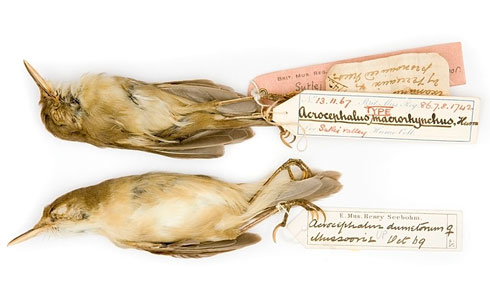Taxonomy
This bird is a classic little brown warbler, with a noticeably long bill and the following characteristics:
- upper parts are uniformly dark brown with a very faint olive cast
- under parts off-white or cream-tinged with slightly buff and olive sides of breast and flanks
- narrow whitish supercilium
- sexes similar
- juvenile plumage warmer brown and more rufous-tinged
- wing length 60–65.5mm
- tail length 50.5–60mm
- tarsus length 22.5–23.8mm
- hind claw length 7.1–7.8mm
- bill length (tip to skull) 18.0–20.6mm
Evolution
Molecular analysis suggests that the large-billed reed warbler is most closely related to, but clearly distinct from, Blyth’s reed warbler, and that these 2 species form a sister clade to one comprising the marsh warbler (Acrocephalus palustris), Eurasian reed warbler (Acrocephalus scirpaceus) and African reed warbler (Acrocephalus baeticatus).
Look-alikes
It is similar in appearance and behaviour to some other Acrocephalus warblers, notably Blyth’s reed warbler (Acrocephalus dumetorum), which is why specimens were overlooked for so long in museums and the species was not noted in the field.
Acrocephalus orinus is most easily separated from Blyth’s reed warbler by a combination of hind claw length and bill length, both of which are greater in the large-billed reed warbler.
Identification of individuals should still be confirmed where possible by DNA analysis.

Separation of large-billed reed warbler (A. orinus) from Blyth’s reed warbler (A. dumetorum) by means of hind claw and bill lengths (in millimetres). Svensson et al., 2010. The definitive version is available at
http://onlinelibrary.wiley.com/doi/10.1111/j.1474-919X.2009.01004.x/abstract
© British Ornithologists' Union Journal, Blackwell Publishing.
